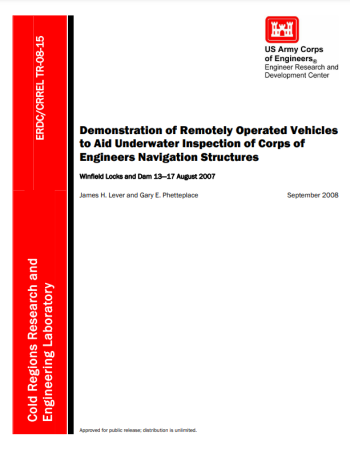Demonstration of Remotely Operated Vehicles to Aid Underwater Inspection of Corps of Engineers Navigation Structures (ERDC/CRREL TR-08-15): Difference between revisions
(Created page with "{{References Template |author= <!-- Add document author/publisher below--> U.S. Army Corps of Engineers |date= <!-- Add publication year --> 2008 |picture= <!--create a file below in format File:example.png, then add picture to that file--> File: ROVinspection.PNG |link= <!-- Add Url to document below (To retrieve URL from a pdf, add document as a pdf file and copy link address from its page--> https://rms.usace.army.mil/datafiles%5CContractors%20Guide.PDF |abstr...") |
No edit summary |
||
| Line 15: | Line 15: | ||
|link= | |link= | ||
<!-- Add Url to document below (To retrieve URL from a pdf, add document as a pdf file and copy link address from its page--> | <!-- Add Url to document below (To retrieve URL from a pdf, add document as a pdf file and copy link address from its page--> | ||
https:// | https://damtoolbox.org/images/e/e0/CRREL-TR-08-15.pdf | ||
|abstract= | |abstract= | ||
Latest revision as of 17:17, 5 December 2023
U.S. Army Corps of Engineers, 2008

We organized a demonstration of remotely operated vehicles (ROVs) at Winfield Locks and Dam to assess their merits to aid underwater inspections at U.S. Army Corps of Engineers navigation facilities. The demo was informative, not competitive, with tasks varying according to concurrent diver-based inspections. The demo illustrated that commercially available ROVs can significantly aid divers, not replace them, in conducting underwater inspections. ROVs increase safety whenever their use precludes the need for divers and through pre-dive reconnaissance when dives are unavoidable. They also offer shorter mobilization, easier access to confined areas, and permanent visual inspections records. When gates are closed, ROVs can work safely within the turbulent leakage flow in stilling basins and could in principle be used to investigate leaky valves and gates with no risks to divers. Learning curves for the systems demonstrated were shortened by the divers’ exceptional knowledge of the underwater terrain and components to be inspected. Sonar was essential to navigate the ROVs in the low-visibility conditions, and the imaging sonar’s quasi-3D images made precision navigation easier. The costs of ROV systems are modest in relation to capital equipment common at locks and dams, and pale in comparison to the expense of unplanned maintenance arising from insufficient inspection coverage.
Revision ID: 7773
Revision Date: 12/05/2023
